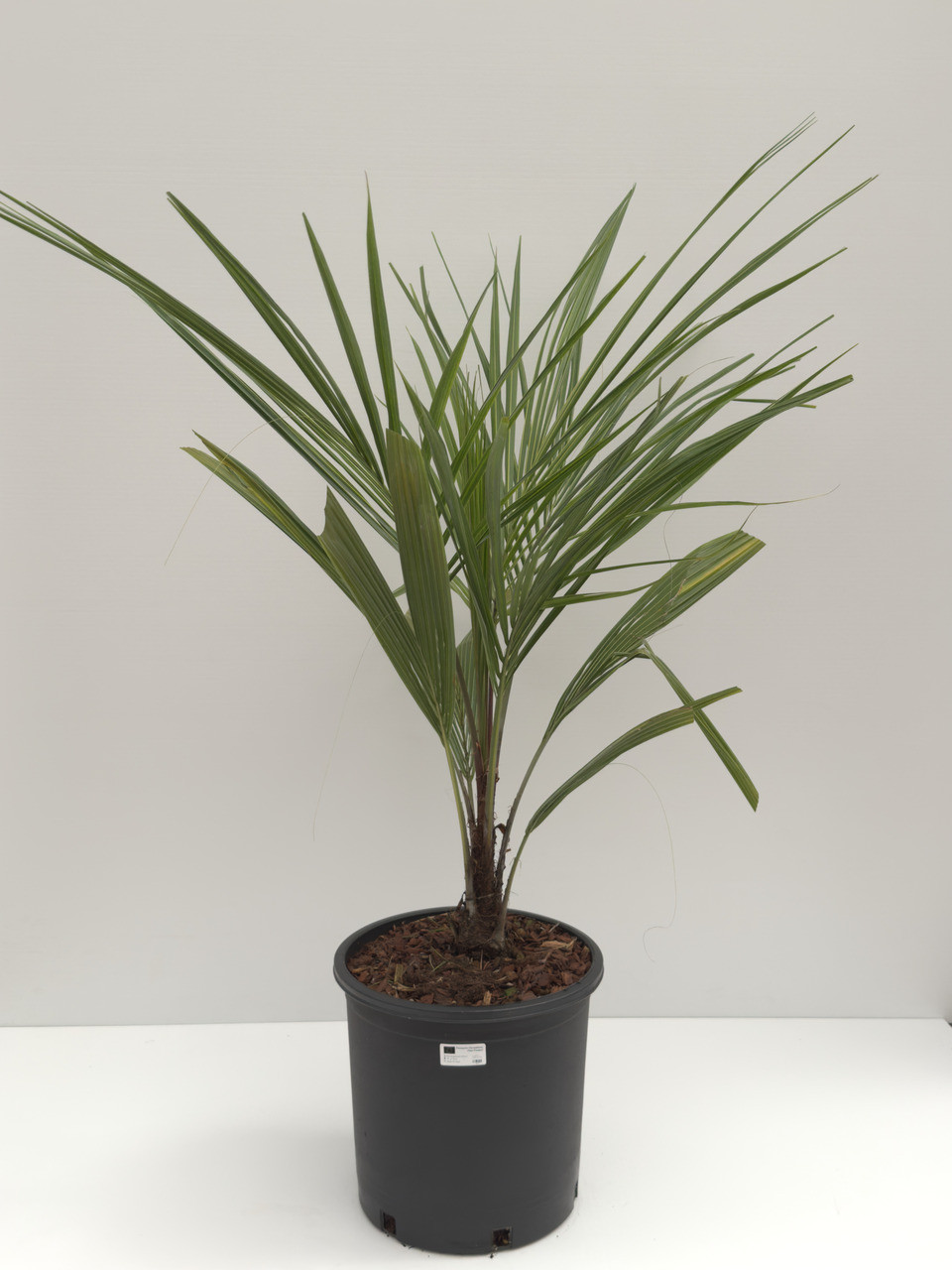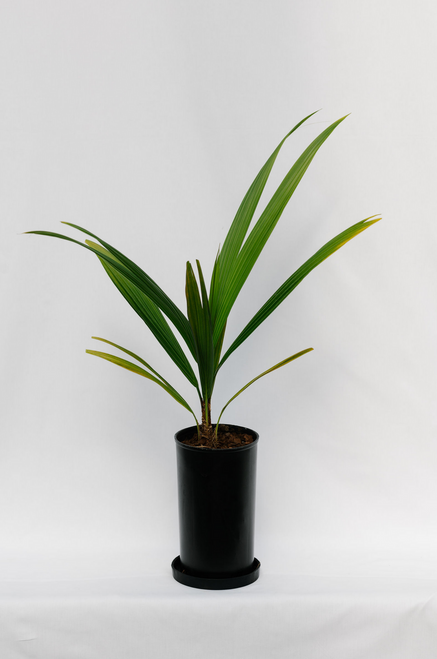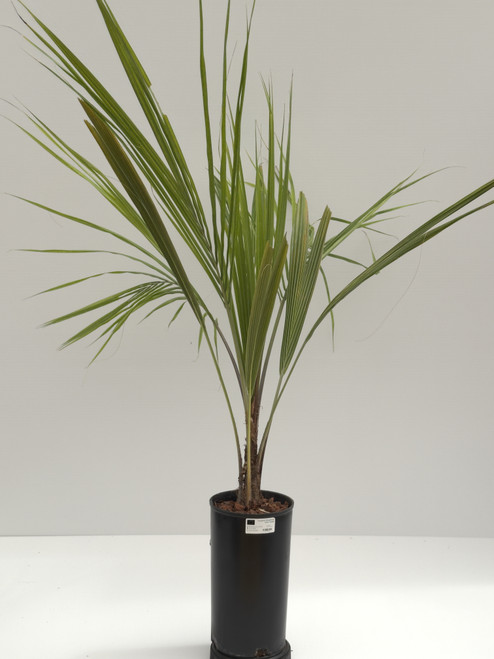Product Description
Habitat and distribution
Beccariophoenix alfredii occurs in the High Plateau of Madagascar at approximately 20 degrees south. The palm is found at an elevation of 1,050 meters (3,440 feet) growing along the sandy riverbeds. The surrounding vegetation is mainly composed of various grasses, and the area sees occasional fires. Due to the environment that B. alfredii is subjected to, it is hardy against frost and cold, fire, drought, full sun, and possibly hurricanes.
Endemic to Madagascar. At the moment, the only scientifically proven and recorded locality for B. alfredii is Manalazina. This population is limited to the west by the Mania River. Individuals become abruptly very rare as soon as one approaches the Mania, the river into which the tributary lined with Beccariophoenix flows. Fewer than twenty individuals of B. alfredii grow on the banks of the Mania, possibly because of its depth, which is unfavorable to the dispersal and establishment of seedlings. As we climbed up another mountain chain in the hope of finding other populations in further localities, we saw not one palm on the horizon. Because of the extremely difficult access and the time we had already taken to reach Manalazina, we were unable to conduct further searches for the palm. Meanwhile, we are optimistic concerning the existence of more populations further away in the region. Justin Moat, GIS specialist at the Royal Botanic Gardens, Kew, using satellite imagery, has looked for habitats similar to that at Manalazina. After analysing the very distinctive spectrum and relief seen in the satellite images at the exact coordinates of Manalazina, Justin was able to search for similar spectra and relief elsewhere in this part of the plateau. He found similar habitats but much further away from Manalazina. Other populations of B. alfred;i surely exist in the area - during our visit, we did not have the time to revisit Vilanitelo where the palms was first seen by Alfred's collectors, nor Marovato, the site of the large population mentioned by Alfred. (M. Rakotoarinivo, T. Ranarivelo and J. Dransfield. 2007)/Palmweb.
Desription
Beccariophoenix alfredii, also known as the High Plateau Coconut Palm, is a recently discovered species of Arecaceae (palms), endemic to Madagascar. It is in the genus Beccariophoenix, and is closely related to the genus Cocos. Beccariophoenix alfredii is very similar in appearance to the coconut palm, although somewhat cold hardy, making it a good look-alike for the coconut in cooler climates. They are hardy down to about 25°F (-3°C) when young, and likely colder when more mature. Editing by edic.
Culture
Due to its overall hardiness, B. alfredii is a good candidate for cultivation in central and southern Florida, California and also locations such as Sydney Australia, Southern Spain, Portugal and Northern New Zealand. It is best grown in sandy loam soils, but is suitable to many other soil types. Besides B. alfredii, there are 2 other species of Beccariophoenix: B. madagascariensis, and Beccariophoenix sp. Windows. Beccariophoenix sp. Windows was known for its moderate growth speed, high nutrient requirements and cold sensitivity. Beccariophoenix madagascariensis was known for its cold hardiness and lack of nutritional problems, but had about one-fourth the growth rate of Beccariophoenix sp. Windows. Both species look remarkably similar to the coconut palm when mature, but with a much broader trunk. Beccariophoenix alfredii seems to combine the good characteristics of both, with the growth rate of Beccariophoenix sp. Windows and the cold hardiness and lack of nutritional problems of B. madagascariensis, but B. alfredii has a slimmer trunk, more like that of the coconut palm. All species appear resistant to lethal yellowing, so may be suitable for areas that have a high instance of the disease. Although relatively new to cultivation, B. alfredii is already becoming popular to palm collectors, and is being called the California Coconut of the future. It can be expected that after it is less new to cultivation, it may become extremely popular worldwide due to its coconut look-alike status, good growth rate, and cold hardiness. Although the trunk normally grows straight, it may develop a curve similar to that of the coconut palm if planted on its side when a few years old.
Comments and Curiosities
Beccariophoenix alfredii exhibits some window panes in the fronds as a juvenile, although not as many as the window pane version of Beccariophoenix. As a seedling, Beccariophoenix alfredii takes quite a long time to go from monofid leaves to bifid leaves, to bifid leaves with minimal windows to fully pinnate leaves, which is quite different than the "no windows" Beccariophoenix madagascariensis, which undergoes these changes relatively quickly. Therefore, although seedlings of Beccariophoenix alfredii exhibit some similarities to Beccariophoenix madagascariensis, it is quite distinct. Due to the recent discovery of Beccariophoenix alfredii, growth speeds aren't entirely known, but a few things can be gathered from the time it has been known. In tropical and subtropical climates, such as Hawaii or Florida, Beccariophoenix alfredii may be the fastest of the 3 species, but for Mediterranean climates, Beccariophoenix seems to only be marginally faster in growth than the "no windows" Beccariophoenix madagascariensis. These are just educated guesses however, and more time needs to be permitted to allow proper scrutinization on growth rate. Another curiosity is development of "twins" within a single seed. Both seeds can germinate, resulting in a double germinated seed. So far, this appears to be relatively common, but it isn't known whether or not the trait can be inherited.
Windows in Juvenile palms: The photos below, are showing 'windows' in alfredii seedlings. These will be watched as new leaves are produced.












